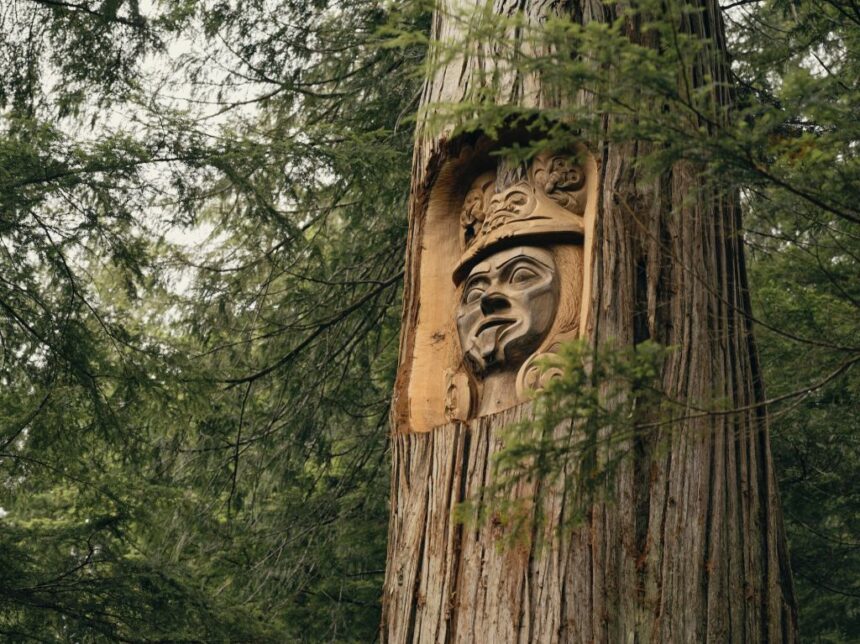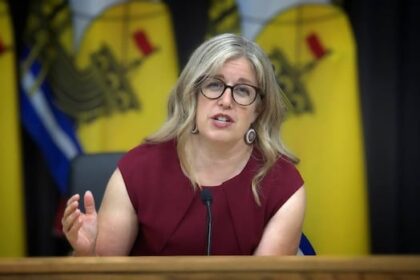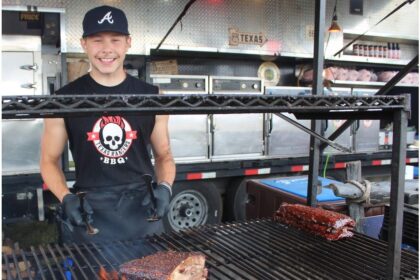A morning fog has cleared at the Kelsey Bay log sort near the town of Sayward, B.C., on Vancouver Island. Thick drifts of pulverized cedar bark pile against the loading dock, evidence of the millions of trees that departed from here across the ocean, never to return. “We’ve seen our territories decimated,” Wei Wai Kum Chief Christopher Roberts explains. Behind him, five freshly cut, old-growth cedars line the warming pavement. These trees, Roberts says, help explain why the nation is here today. After watching trees vanish from their territory for more than a century, nations are claiming sizable stakes in an industry that has long excluded them. Wei Wai Kum is one of four First Nations to purchase a $36-million stake in La-kwa sa mukw Forestry Partnership, a joint operation with logging company Western Forest Products Ltd. Their partnership came after companies including Western Forest Products agreed to leave the biggest, canoe-carving trees like these in their communities. A sign, for Roberts, that the industry was willing to change. First Nations’ territories have long played a key role in B.C.’s logging industry, with old-growth trees being chopped down for timber. Now, in towns like Sayward, B.C., nations like Wei Wai Kum are buying up forestry tenures with hopes of reshaping the industry. Photo: Taylor Roades / The Narwhal “If it wasn’t for that, I don’t think Wei Wai Kum would have had the confidence to enter into the purchase agreement,” Roberts says, addressing the small crowd before him, some seated on fold-up chairs for the day’s events celebrating the partnership. Their purchase last year adds to a wave of new First Nations-owned forestry tenures in B.C., which jumped from 10 to 20 per cent of the province’s logging allowance in the last four years. According to the Ministry of Forests’ budget notes, tenure transfers to First Nations are “occurring at a faster rate than anticipated.” But the long-awaited opportunity comes at a turbulent time: B.C.’s major logging companies are liquidating their mills and licences, and moving much of their operations to the southern U.S. It’s a trend that, according to industry testimony at the U.S. International Trade Commission, is “highly unlikely to reverse itself in the foreseeable future.” B.C. timber companies have been liquidating their assets and moving their operations south. With 45 per cent tariffs recently placed on Canadian timber by the Trump administration, the trend seems poised to continue. Photo: Taylor Roades / The Narwhal A crowd gathers to listen to speeches at a La-kwa sa mukw Forestry Partnership event in Sayward, B.C. Wei Wai Kum First Nation, whose chief Christopher Roberts is pictured on the right, is one of four nations who purchased a stake in the joint venture with Western Forest Products Ltd. Photos: Taylor Roades / The Narwhal Reasons for the upheaval are varied, but Garry Merkel, a professional forester and a member of the Tahltan Nation, points to a pervasive, underlying factor: most of the highest-value big trees are gone, and many of B.C.’s mills are built to process lots of trees at once. “Everybody is competing for the last little bit,” he says. That puts some First Nations-owned tenures in a pressure cooker, trying to supply the wood to keep forestry-reliant communities going while working to steward ecosystems under growing strain. Right now, Roberts remains uncertain whether that high-wire act is achievable. “I’ve always believed that when First Nations are the ones that take over the ownership of licences and tenures in their territory, it would be a different value set they would have used,” he says. “I’m just not seeing that yet.” B.C. forestry: a flawed system First Nations had been using and stewarding the province’s forests for millennia when 27-year-old Henry Reginald MacMillan — better known in B.C. as H.R. MacMillan — a third-generation Canadian settler with roots in Scotland, arrived in Victoria in 1912 to launch the province’s first forest service. He came with a radical plan, learned in the continent’s new fleet of forestry schools, to transform B.C.’s forests into a planted crop of trees, like peas or potatoes. Major forest companies would be the foot soldiers of this revolution, and were granted long-term licences from the British Columbia government to log First Nations’ territories, without their input or consent.For decades, companies bought and sold access to First Nations’ land like trading cards. First Nations people, meanwhile, were forced onto reserves. “You couldn’t go off a reserve,” Merkel says. “You couldn’t own land.” Under the Indian Act, they also couldn’t hire lawyers, preventing them from advocating for their rights in the bustling resource economy. Many First Nations people worked in the industry, but they were excluded from decision-making or ownership. In 1991, nations held less than one per cent of the province’s logging tenure. The largest ten companies in the province, including MacMillan’s own company, MacMillan Bloedel Ltd., held almost 70 per cent. H. R. MacMillan, who launched B.C.’s forestry service in the early 20th century, was an architect of the province’s ambitious vision for logging, which relied on First Nations’ territories even as it excluded the nations’ members themselves. Photos: Supplied by the Campbell River Museum Meanwhile, the industry supersized its tools to cut forests faster, including megamills and mechanized logging machines. B.C.’s companies refined their approach to high-volume, low-value forestry and companies saw their incomes skyrocket. Many First Nations resisted the growing scale of forestry in their territories. Landmark legal victories for the Haida, Gitxan and Wet’suwet’en and other nations throughout the 1990s and 2000s prompted B.C. to change its approach to forestry in the province. “They realized they had to figure out how to work with the community,” Merkel says. In 2010, B.C. introduced a suite of new policies, including a revenue-sharing program to allocate a share of its logging proceeds to impacted nations, many of which remain in place today. But those agreements also came with strings, including clauses restricting nations’ ability to contest companies’ logging in their territories. “We think they’re a flawed system,” Chief Councillor waamiiš Ken Watts of Tseshaht First Nation says. The nation owns various forestry tenures on southern Vancouver Island.. “It’s just saying, here’s our colonial laws you have to live by, sign this agreement, we’ll give you a bit of change at the end of the year from what we’ve made off of your territory,” he says Those agreements came with some new opportunities for First Nations-owned tenure, but many of the licences came with caveats: unlike major forest companies, licensees had a limited window to log wood, and some were limited to pine beetle-killed areas. Many of the licences were never fully utilized. Opportunity in the B.C. forestry crash Now, after years on the margins, First Nations’ tenure opportunities have exploded as B.C.’s biggest forest companies sell off major parts of their long-held licences. “We’re seeing fire sales all over the place,” Merkel says.Companies like Interfor and Canfor have sold up to half of their timber licences to First Nations. Western Forest Products has taken a more incremental approach, entered into co-owning arrangements, including with the Huu-ay-aht First Nation and through La-kwa sa mukw Forestry Partnership. But the opportunity comes with a bitter pill: the industry is in freefall. Merkel sees some multinational corporations are jumping ship. “As long as they get something out of it and get out of the liability, that’s cash they can take and go buy, I don’t know, a shrimp farm in Africa or something.” U.S. softwood lumber tariffs, which rose to 45 per cent this month, are the latest shock. And Merkel points to other, more insidious causes for the crash: namely, that H.R. MacMillan’s forest project didn’t work as planned. Planted forests haven’t grown into the old, big trees industry made its fortunes from. In 2024 and 2025, carvers from the K’omox, We Wai Kai and Wei Wai Kum nations carved two xwax’wana, or canoes, from windfall cedars in H’kusam Forest, as well as living poles celebrating the nations’ culture and forestry history in Sayward, B.C. Photo: Taylor Roades / The Narwhal “Now we’re dealing with a lot of scrub in that corner that we didn’t get to before,” Merkel says. Mills, meanwhile, are often designed to log lots of wood — often the big, old stuff. Some nations who paid handily for their recent tenures are in “tough situations,” Merkel adds. “They’re bound economically.” That crunch can incentivize faster, cheaper, clear-cut logging, even though old growth is often scarce. For some nations, the situation may worsen. As logging declines across the province and the price of wood falls, B.C. has warned that revenue sharing on forestry with First Nations will see a sizable drop, with “the first major decline in payments” beginning this year. Meanwhile, federal funding cuts loom for Indigenous Services Canada. The department provides key services like health care, drinking water and education — things non-Indigenous communities have had disproportionate access to, thanks in part to forestry revenue. Those vacillating government funds underscore Chief Ronnie Chickite’s desire to establish financial independence through tenure ownership. “I think we got in at the right time,” says Chickite, whose community We Wai Kai First Nation is one of the four nation members of La-kwa sa muqw Forestry Limited Partnership and owns other forestry companies. With the forestry industry in “fire sales all over the place,” according to Garry Merkel, a forester and member of the Tahltan Nation, some nations are now in a difficult place and bound to forest tenures that are not economically productive. Photo: Taylor Roades / The Narwhal But dividing the shrinking pie may become more difficult. The La-kwa sa muqw partnership, for example, faces ongoing job action from United Steelworkers, which disputes the company’s intent to hire a segment of non-union workers. And it surfaces another tension: the Ma’a̱mtagila Hereditary Chiefs claim rights to territory where the partnership is licensed to log, and have called for a halt to the company’s operations, which includes logging in big-treed, old-growth forests. Canada and B.C. currently do not recognize the Ma’a̱mtagila nation after its amalgamation with the Tlowitsis, one of the La-kwa sa mukw partnership-owning First Nations. “The Ma’a̱mtagila never gave their land away,” said Chief Nelson Bruce of the Hayalikawayi namima clan, in a press release.In recent estimates notes, the B.C. Ministry of Forests acknowledged that tenure sales can trigger unique conflicts when First Nations tenures extend across other nations’ territories. Elsewhere, other configurations of these tensions have erupted: a co-owned tenure between Western Forest Products and Huu-ay-aht First Nation faces a blockade protesting the company’s logging led by Pacheedaht Elder Bill Jones — who opposes his own nation’s decision to consent to old-growth logging in its territory. “There is very little left,” Jones said in an August press release. “We must save it for our children and all the children to come.” ‘It is possible’: First Nations charting alternative paths in forestry Over the years, Merkel says many nation-owned tenures have been leading the charge by managing forests in a way that doesn’t tax their future. “We’re seeing much higher standards of land care and a lot more focus on ecological health and the relationship to the land,” he said. “It is possible,” Naxginkw Tara Marsden, Wilp Sustainability director with the Gitanyow Hereditary Chiefs says. Besides adhering to the Gitanyow Lax’yip Land Use Plan, which protects 51 per cent of the territory, Marsden says the nation’s own tenure exceeds the land use plan’s standards, and it is researching different approaches to leaving trees standing in cutblocks. Forest tenure sales can trigger conflicts when some First Nations’ tenures extend into other nations’ territories. A blockade erupted in August in the Walbran Valley, led by Pacheedaht Elder Bill Jones, who opposes his own nation’s decision to log old growth in its territory. Photos: Mike Graeme / The Narwhal By sending their wood to a local, value-added mill which employs many of the nation’s members, Marsden says Gitanyow can get more for their trees, creating more breathing room to innovate. Marsden wants to see B.C. address decades-old deregulation that let companies close their local mills in the first place, by restoring appurtenancy rules, which required logs to be milled in the regions where they were cut. Marsden, Watts and Roberts are among those looking for change in B.C.’s log pricing system, also known as stumpage fees. That could mean reducing stumpage rates for certain types of forestry, like logging in second growth or selective harvest.Currently, Watts says, it’s not affordable to do that kind of logging. “If it’s not affordable to go out, we can’t do those really creative [cutblocks] that everybody wants us to do … The value of it all through the whole chain has got to make sense for everybody.” A tree-blessing ceremony at Kelsey Bay in Sayward, B.C. Five old-growth trees are blessed by Wei Wai Kum Chief Christopher Roberts, We Wai Kai Chief Ronnie Chickite and others. Photo: Taylor Roades / The Narwhal Alexandra Thomas, a member of the Tlowitsis Nation with shíshálh ancestry and a forest stewardship coordinator with the Nanwakolas Council, one of the La-kwa sa muqw partners, is interested in using forests to harvest other, non-tree products, like medicines and foods. “Here’s how you get more people into the forest, into the places that they should be observing and paying attention and spending time,” she says. Deepening communities’ relationships to forests, Thomas says, is critical to shift away from B.C. forestry’s long-held tunnel vision that prioritizes economic values over ecological and cultural ones. “We have paths before us, and we get to choose the path,” she says. Changing the system The late afternoon’s sun beats down as Chief Roberts finds a place to sit by the sidelines. He gestures to the nearby Salmon River, which, true to its namesake, once housed an abundance of the fish, and which has almost disappeared, in part, he says, due to the impacts of widespread logging across the watershed. Back when the fish were abundant, a young, college-bound H.R. MacMillan was holed up on a boat a few miles upriver, nursing an axe wound to his left hand as his colleagues staked out timber licences throughout the watershed. He was there when the first logging equipment arrived on wide boats. That fall, the watershed’s trees began to disappear. Roberts is waiting for a sign that tenure ownership will usher in the forest’s new chapter. “I often find myself really conflicted,” Roberts says of his involvement in the industry today. “It’s really hard to change a system … It’s just like the train is going and you can’t stop it.” But Roberts remains cautiously hopeful for what’s ahead. “It’s just finding the right balance and levers to pull,” he says. “Right now in B.C., it’s not even close to equitable.” Recent Posts ‘It’s not even close to equitable’: B.C. First Nations push to reshape forestry Oct. 15, 2025 12 min. read Nations across B.C. are buying into forestry tenures once controlled by multinational companies. But with… Basia Bulat sings the western chorus frog’s praises Oct. 14, 2025 10 min. read The Montreal-based musician talks about her latest album, becoming a mother and the tiny endangered… Ontario is subsidizing an energy project in Georgian Bay despite expert advice Oct. 14, 2025 5 min. read An internal memo from Ontario’s electricity system operator outlines concerns with TC Energy’s large pumped…
Its not even close to equitable: B.C. First Nations push to reshape forestry











